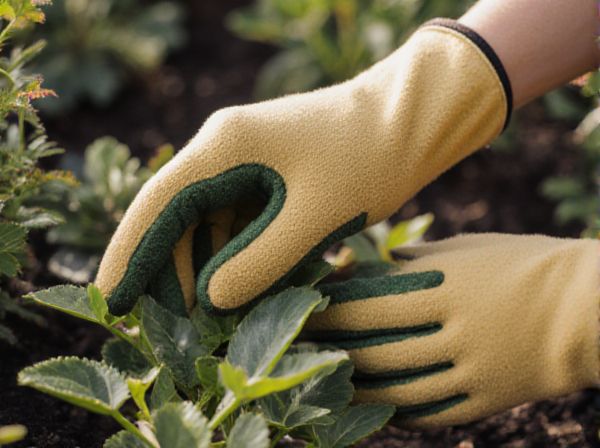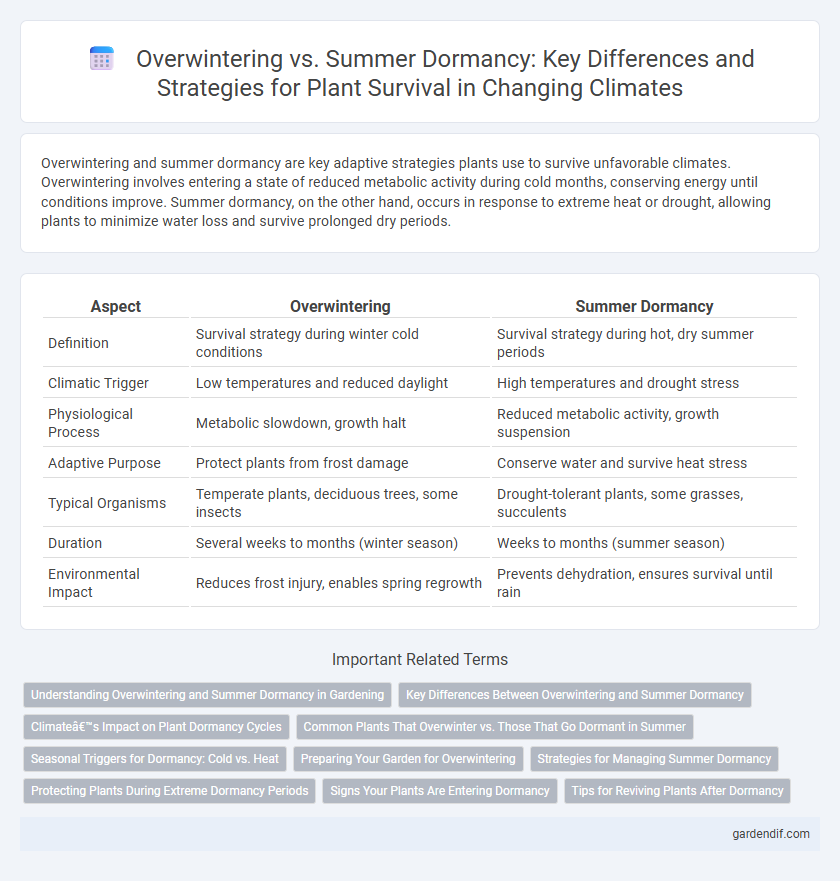
Overwintering vs Summer dormancy Illustration
Overwintering and summer dormancy are key adaptive strategies plants use to survive unfavorable climates. Overwintering involves entering a state of reduced metabolic activity during cold months, conserving energy until conditions improve. Summer dormancy, on the other hand, occurs in response to extreme heat or drought, allowing plants to minimize water loss and survive prolonged dry periods.
Table of Comparison
| Aspect | Overwintering | Summer Dormancy |
|---|---|---|
| Definition | Survival strategy during winter cold conditions | Survival strategy during hot, dry summer periods |
| Climatic Trigger | Low temperatures and reduced daylight | High temperatures and drought stress |
| Physiological Process | Metabolic slowdown, growth halt | Reduced metabolic activity, growth suspension |
| Adaptive Purpose | Protect plants from frost damage | Conserve water and survive heat stress |
| Typical Organisms | Temperate plants, deciduous trees, some insects | Drought-tolerant plants, some grasses, succulents |
| Duration | Several weeks to months (winter season) | Weeks to months (summer season) |
| Environmental Impact | Reduces frost injury, enables spring regrowth | Prevents dehydration, ensures survival until rain |
Understanding Overwintering and Summer Dormancy in Gardening
Overwintering in gardening involves protecting plants from cold winter temperatures by using methods such as mulching, indoor relocation, or covering with frost cloth to ensure survival until spring. Summer dormancy occurs when plants enter a period of reduced metabolic activity during hot, dry months, conserving water and energy to withstand stress. Understanding these adaptive strategies helps gardeners optimize plant care by timing watering, pruning, and soil management for seasonal resilience.
Key Differences Between Overwintering and Summer Dormancy
Overwintering involves plants or animals entering a dormant or less active state during winter to survive cold temperatures, while summer dormancy occurs in response to extreme heat and drought conditions. Key differences include the triggers, with overwintering initiated by decreasing temperatures and photoperiod changes, whereas summer dormancy is driven by high temperatures and water scarcity. Additionally, metabolic rates drop significantly in overwintering to conserve energy during cold months, whereas summer dormancy often involves physiological adaptations to minimize water loss and heat stress.
Climate’s Impact on Plant Dormancy Cycles
Climate significantly influences plant dormancy cycles by dictating the timing and duration of overwintering and summer dormancy phases. Cooler temperatures and shorter photoperiods trigger overwintering dormancy, allowing plants to survive harsh winter conditions by temporarily suspending growth. Conversely, in regions with hot, dry summers, summer dormancy enables plants to conserve water and energy by halting growth until favorable conditions return.
Common Plants That Overwinter vs. Those That Go Dormant in Summer
Common plants that overwinter, such as pansies, hellebores, and kale, thrive in cold temperatures by maintaining active growth or flowering through winter months. In contrast, summer dormancy is characteristic of perennials like daylilies, peonies, and some bulbous plants, which enter a period of metabolic slowdown during hot, dry seasons to conserve energy. Understanding the adaptive strategies of overwintering versus summer dormancy aids gardeners in selecting species best suited for regional climate cycles.
Seasonal Triggers for Dormancy: Cold vs. Heat
Plants enter overwintering dormancy triggered primarily by declining temperatures and shorter daylight hours, which signal the onset of cold stress. In contrast, summer dormancy is induced by high temperatures and drought conditions, prompting physiological changes to conserve water and energy. These seasonal triggers influence metabolic slowdown, hormone regulation, and gene expression critical for survival through adverse climatic periods.
Preparing Your Garden for Overwintering
Preparing your garden for overwintering involves protecting plants from harsh winter conditions by using insulating materials such as mulch, straw, or frost cloths to maintain soil warmth and moisture. Evergreen shrubs and perennials benefit from thorough watering before the ground freezes, while pruning should be minimal to avoid stimulating new growth vulnerable to cold damage. Creating windbreaks or using cold frames can further shield delicate plants, ensuring they survive until the growing season resumes by preventing desiccation and frost injury.
Strategies for Managing Summer Dormancy
Summer dormancy in plants involves a temporary halt in growth to conserve water and energy during hot, dry conditions, contrasting with overwintering strategies aimed at surviving cold seasons. Effective management of summer dormancy includes selecting drought-resistant species, implementing optimized irrigation schedules, and applying mulching techniques to retain soil moisture. Understanding physiological responses such as stomatal closure and reduced metabolic activity enhances the ability to maintain plant health and productivity during prolonged heat stress.
Protecting Plants During Extreme Dormancy Periods
Overwintering and summer dormancy are critical survival strategies for plants facing extreme climatic conditions, where metabolic activities significantly slow down to conserve energy. Protecting plants during these dormancy periods involves ensuring adequate insulation through mulch or protective covers, regulating soil moisture to prevent desiccation or waterlogging, and selecting hardy species adapted to local temperature extremes. Effective management of overwintering and summer dormancy enhances plant resilience and promotes sustainable growth despite harsh environmental stressors.
Signs Your Plants Are Entering Dormancy
Signs your plants are entering dormancy include slowed growth, yellowing or dropping leaves, and reduced water uptake. During overwintering, many plants develop thicker, more protective foliage or shed leaves entirely to conserve energy. In summer dormancy, plants may exhibit wilting or leaf curling as adaptations to heat and drought stress.
Tips for Reviving Plants After Dormancy
To revive plants after overwintering or summer dormancy, gradually reintroduce them to increased sunlight to prevent leaf burn and encourage healthy photosynthesis. Ensure consistent watering, avoiding both overwatering and drought stress, to promote root recovery and growth. Applying a balanced, slow-release fertilizer supports nutrient uptake and strengthens plant resilience during the transition period.
Overwintering vs Summer dormancy Infographic

 gardendif.com
gardendif.com